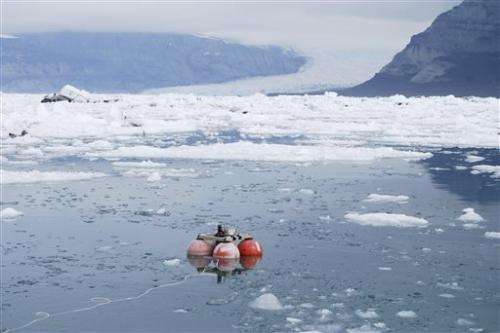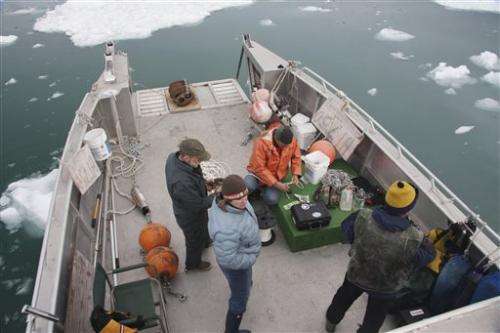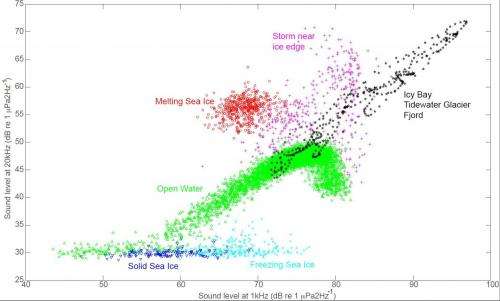Bubbles from glacier ice turn up the noise in Alaska fjords

Glaciologist Erin Pettit began a research project to find out what humpback whales heard when a big piece of ice falls from a glacier and crashes into the ocean. But the sound generated by ice drifting in the water turned out to be just as interesting.
Acoustic research in Alaska's Icy Bay and other glacier ice-filled waters found that the fizz created by the release of pressurized air bubbles within glacier ice makes fjords the noisiest places in the ocean.
"The glacier fjord sound on a typical day for Icy Bay is louder than being in the water beneath a torrential downpour, which really surprised me," said Pettit, a researcher at the University of Alaska Fairbanks.
In a paper published in Geophysical Research Letters, a journal of the American Geophysical Union, Pettit and fellow researchers speculate that one reason harbor seals flock to fjords with tidewater glaciers is because noisy icebergs provide acoustic camouflage, protecting seals from transient killer whales that hunt by sound.
In July 2009, the researchers deployed underwater microphones 70 meters deep in Icy Bay, a fjord near the top of the Alaska Panhandle just 4 miles from 18,008-foot Mount St. Elias. They also sampled sound at nearby Yakutat Bay and at Andvord Bay in Antarctica.
Researcher Jeff Nystuen of the University of Washington's Applied Physics Laboratory, who had had used hydrophones to measure the underwater sound of rainfall, quickly realized the significance of the sound collected in the fjords, Pettit said.
"He was kind of blown away when I showed him the results of our data set," she said. "He's like, 'This is really, really loud.'"
Colleagues at the University of Texas at Austin conducted laboratory tests in acoustic tanks with Alaska glacier ice to find out how bubbles make noise. They recorded air bubbles making a bloop, tick or pop sound as they separated from ice, a sound that lasts 10 milliseconds or less.

"The bubble rising through the water is relatively silent," Pettit said. "The bubble hitting the surface is also relatively silent."
The snow compressing to ice on a glacier creates bubbles of nearly the same size under the same pressure, Pettit said. That makes for consistent sound underwater.
"In terms of our hearing, the range of those notes is kind of that area that's on the upper half of the piano," she said. "It's centered about three-quarters of the way up to the high end of a piano."
In general, "It's kind of a combination of a babbling brook and a hissing sound," she said.
She compared the sound to sitting next to a busy highway or a river with rapids.
She hopes the findings will be of interest to marine biologists. Harbors seals use drifting ice floes to rest and rear pups.
"This is a question I'm hoping some biologists pick up on: How much do the seals choose those areas because they can use the masking of the glacier sound to protect themselves from (killer) whales?"

She also wonders what will happen when the glaciers retreat from the ocean, as happened with Muir Glacier in Alaska's Glacier Bay National Park.
"That transition is going to be the one that's going to really impact the ecosystem in terms of the sound environment," she said.
Manolo Castellote, a researcher at the National Marine Mammal Laboratory in Seattle, has used acoustics to study beluga whales in Yakutat Bay. He also experienced the sounds of glacier ice crashing into the water, cracking into smaller pieces and bubbling before it melted.
"They are extremely loud," he said, but it's a field where scientists have little information.
With the acceleration of glacier melt, he said, the season for glacier ice in the water likely has been extended. It would be hard to point to the effect of noise on marine mammals, he said, since it's been present since they've existed.
He also said effects from the noise, after bouncing off underwater fjord walls, likely is localized and limited in distance.
More information: Geophysical Research Letters, onlinelibrary.wiley.com/doi/10 … 014GL062950/abstract
Journal information: Geophysical Research Letters
© 2015 The Associated Press. All rights reserved.



















